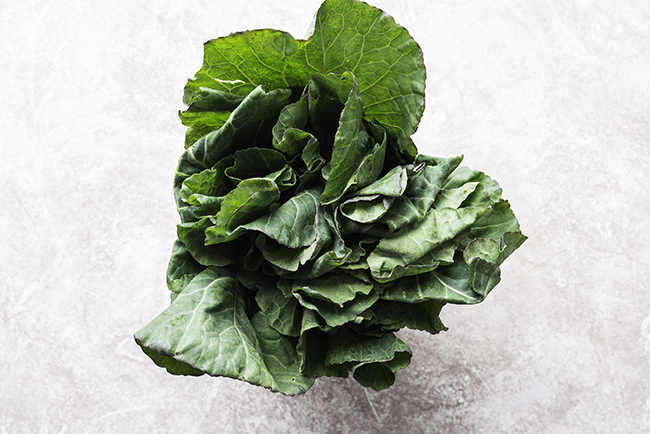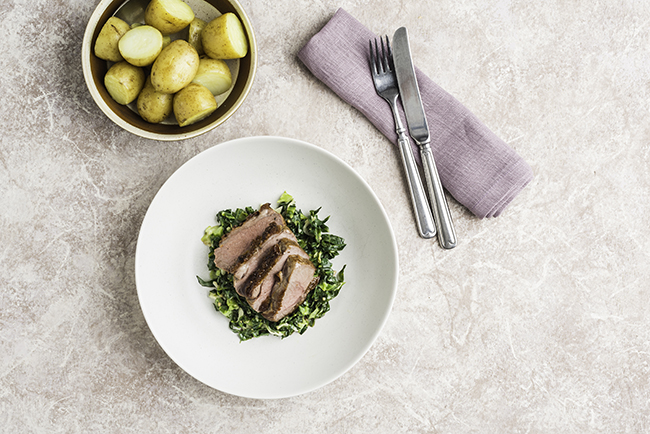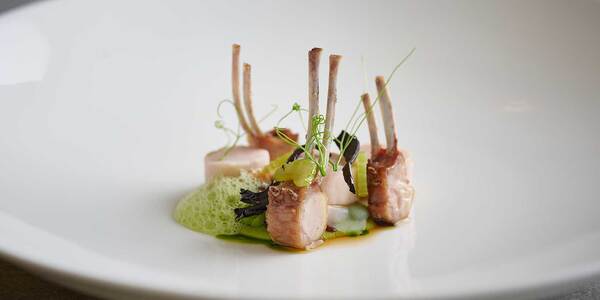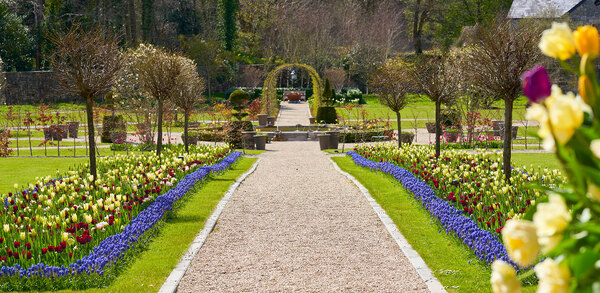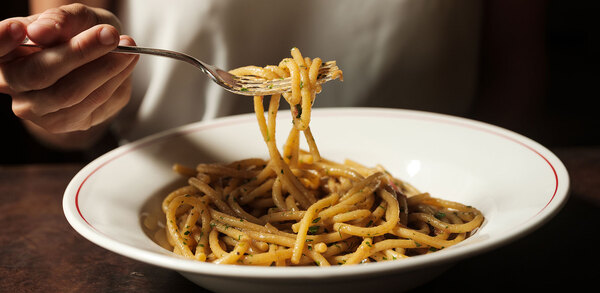Home-grown harvest: spring greens
With the hungry gap approaching, Russell Brown explains how to make the most of this member of the brassica family
As we push through March and head towards April, it is easy to feel that the worst of winter is behind us. The wild garlic is sprouting and many chefs will already be thinking about the English asparagus that will appear soon. But it's worth remembering that we are heading into the ‘hungry gap', when many of our stored vegetables, such as potatoes, onions and roots are running out, but true spring produce hasn't really come to fruition.
There are some things that ease the situation, however, and spring greens are one of them. I don't mean just any greens that are available at this time of year, but specifically the loose, open heads of greens that are similar to a cos lettuce in shape but have no real heart. They are tender, sweet and cook very rapidly. The counties of Cornwall, Lincolnshire and Suffolk are all renowned for their production and, as with many vegetables, companies grow in several areas of the country to smooth out and extend the supply. One such company, TH Clements, is a major brassica grower based in Lincolnshire, growing spring greens on more than 200 acres of land in Cornwall to provide an early season crop.
Spring greens are a cultivar of Brassica Oleracea in the cultivar Acephala group, in which the central leaves do not form a head or form only a very loose one. They provide significant amounts of vitamin C and vitamin K as well as dietary fibre. The stems and leaf ribs are eaten rather than removed as in some other cabbages, and are perhaps the sweetest part of the vegetable. What we call spring greens in the UK are very similar to the American collard greens, whose name comes from the word ‘colewort', the wild cabbage plant. Southern-style collard greens are slowly braised with bacon, onions, garlic, stock and chilli flakes, although there are myriad variations.
When it comes to cooking, spring greens have a variety of uses but simply shredded and steamed or quickly stir-fried with seasoning and butter should not be dismissed. They are not as fibrous as cabbages and take little cooking. The large leaves do lend themselves to rolling or wrapping, too. They have an affinity with garlic and chilli and are often incorporated into soups. The wild garlic I mentioned earlier also pairs well with spring greens.
Chef Bjorn Moen at Pattard Kitchen in North Devon blanches the greens and wok-fries with wild garlic butter, salt and pepper to serve with butter-poached cod and Jerusalem artichoke purée; while personal chef and caterer Steve James, who works across Somerset and Dorset, pan-fries with lots of butter and seasons with salt, pepper, nutmeg and white wine vinegar as a great accompaniment with lamb.
Buying and storage tips • Leaves should be vibrant and crisp
• Avoid heads where the leaves are discolouring at the edges
• Store in the refrigerator
Market report
Spring green cabbage has become more popular over the last year and sales have increased. We are experiencing a small shortage at the minute from our growers in Lincolnshire, which has forced caterers to buy Cornish spring greens as an alternative. Prices have risen because of this, but that shouldn't become a huge issue now we are past the colder months.
Spring greens at the moment will cost £1/£1.10 per kilo, but the average price is 70p/80p per kilo.
Ashley Clemence www.totalproducelocal.co.uk
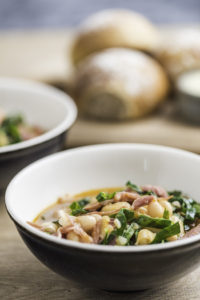
Serves six
For the hock 1 ham hock
1 large carrot, peeled and roughly chopped
1 small onion, peeled and roughly chopped
1 stick celery, roughly chopped
1 bay leaf
6 black peppercorns
For the broth 1 onion, finely diced
2 cloves garlic, sliced
100ml white wine
200g passata, unsieved
1litre ham cooking liquid
1 tin cannellini beans, drained
Shredded meat from ham hock
150g shredded spring greens
75ml good olive oil
Maldon sea salt and freshly ground black pepper
To serve Grated Parmesan
Good extra virgin olive oil
Place the ham hock in a deep saucepan with all the vegetables and aromatics. Cover with cold water and bring to the boil. Skim any foam from the surface and reduce the heat to a simmer. Simmer for 1.5-2 hours, topping up with water as required, until the meat is tender and falls from the bone. Remove the hock and allow to cool enough to handle. Shred the meat roughly and reserve. Pass the cooking liquid to remove the solids and allow to settle. Skim any excess fat from the surface.
In a clean pan, sweat the onion in some olive oil until nearly tender. Add the garlic and sweat for a further five minutes. Add the wine and reduce to a syrup. Add the passata and ham stock and reduce by one-third. Add beans and ham hock meat, cook gently for 10 minutes then add the greens. Cook until the greens are tender. Season to taste and stir in the olive oil.
Serve with grated Parmesan and more olive oil.
Roast rump of lamb with mustardy greens
Serves four
For the rumps 4 lamb rumps, trimmed and fat scored
Maldon sea salt and freshly ground black pepper
50ml olive oil
25g unsalted butter
1 clove of garlic, smashed
4 sprigs of thyme
For the mustardy greens 30ml olive oil
2 shallots finely sliced
2 cloves garlic, finely sliced
1tsp yellow mustard seeds
300g spring greens, finely shredded
1tsp Dijon mustard
50g crème fraîche
25g unsalted butter
Maldon sea salt and freshly ground black pepper
Pinch of sugar
Heat a heavy-based frying pan, season the fat on the lamb rumps, and place them fat side down in the pan. Cook over a medium heat to render the fat. Season the flesh and turn to colour well all over.
Add the oil, butter, garlic and thyme. Turn the meat so it is fat side down, baste and transfer to a hot oven, around 180ºC. Cook for 4-8 minutes, basting occasionally until the required doneness is reached. Medium-rare will be around 48ºC when the meat comes out of the oven. Remove to rest on a wire rack, fat side up.
While the rumps are cooking, heat the olive oil in a deep sauté pan and add the shallots and garlic. Cook over a gentle heat until tender, then add the mustard seeds. Increase the heat and cook until the seeds begin to pop. Add the greens to the pan and stir through the shallot mix, then pour in 50ml water and place a lid on the pan. Steam the cabbage for 3-4 minutes until beginning to soften.
Add the mustard, crème fraîche and butter and cook rapidly until the greens are coated in the mustardy sauce. Season with sea salt, pepper and a pinch of sugar.
Divide the greens between four bowls and top with the sliced lamb rumps. Finish with a little lamb jus and serve with new potatoes, perhaps the first of the Jersey Royals.
Coming soon
Spinach is the next featured vegetable in Home-grown Harvest - do let me know how you like to use this on your menus. Email recipes, dish suggestions and photographs to russell@creativeaboutcuisine.com
Get The Caterer every week on your smartphone, tablet, or even in good old-fashioned hard copy (or all three!).


